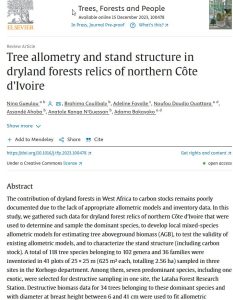
Abstract :
The contribution of dryland forests in West Africa to carbon stocks remains poorly documented due to the lack of appropriate allometric models and inventory data. In this study, we gathered such data for dryland forest relics of northern Côte d’Ivoire that were used to determine and sample the dominant species, to develop local mixed-species allometric models for estimating tree aboveground biomass (AGB), to test the validity of existing allometric models, and to characterize the stand structure (including carbon stock). A total of 118 tree species belonging to 102 genera and 36 families were inventoried in 41 plots of 25 × 25 m (625 m² each, totalling 2.56 ha) sampled in three sites in the Korhogo department. Among them, seven predominant species, including one exotic, were selected for destructive sampling in one site, the Lataha Forest Research Station. Destructive biomass data for 34 trees belonging to these dominant species and with diameter at breast height between 6 and 41 cm were used to fit allometric equations specific to this vegetation type and to test the predictions of existing equations earlier developed for the global tropics and for African dry forests. Six equations integrating three predictors, trunk diameter (D), total tree height (H) and wood specific gravity (ρ) were developed and the models with the three predictors showed the best performance. Pantropical models significantly over-estimated tree AGB by 20% while models developed for African dry forests provided reliable estimates, suggesting a specific allometry of trees in dryland forest relics. With our best local equation, a quantity of 141.26 ± 92.72 tDM.ha−1 was estimated confirming that these dryland forest relics are important carbon stocks for this region where open vegetation dominates. This study constitute an important contribution for the carbon accounting programs related to the implementation of REDD+ initiatives in Côte d’Ivoire.
Consultez la notice complète de l’article sur ORBi
